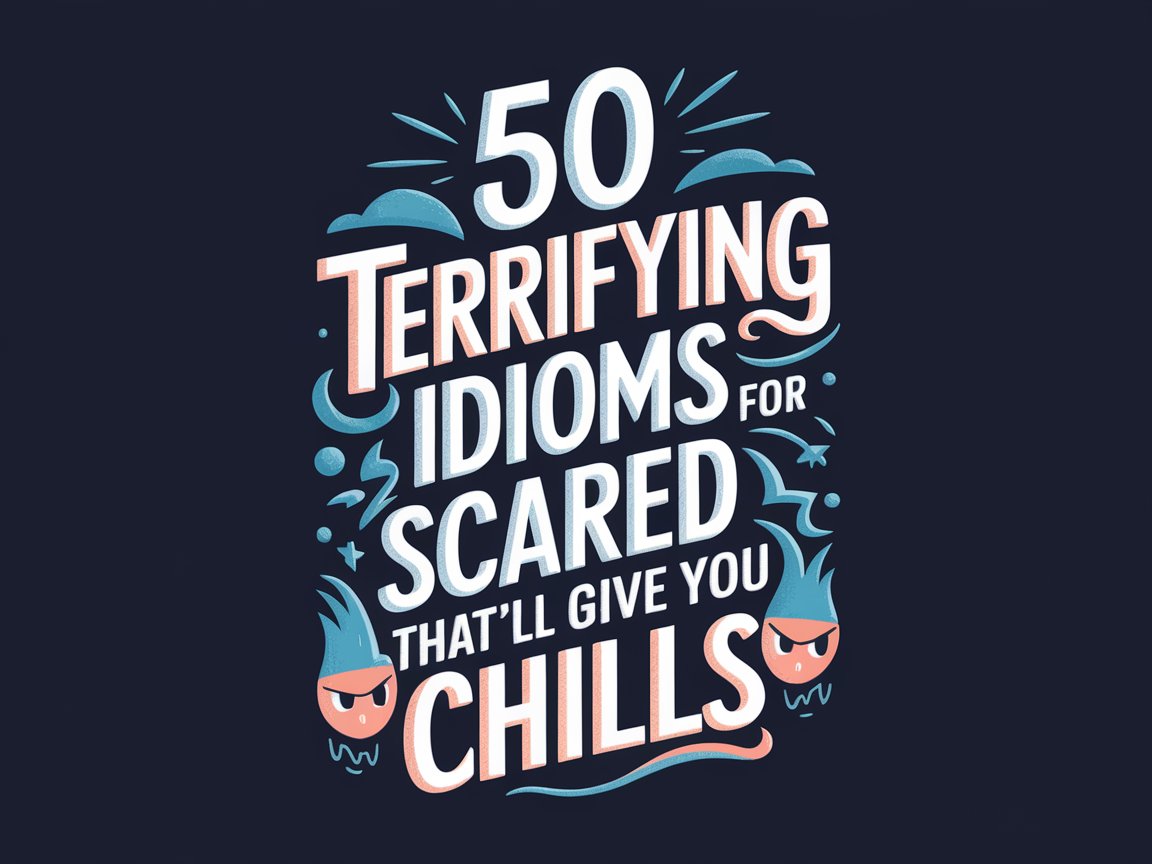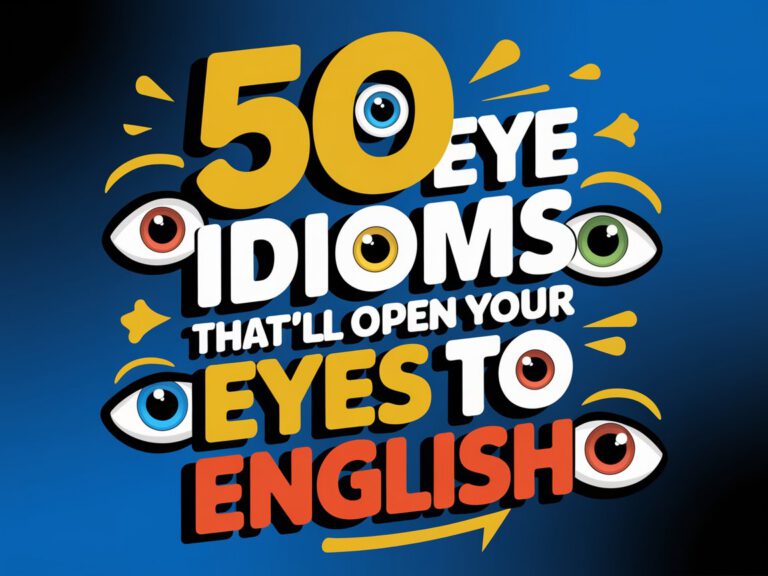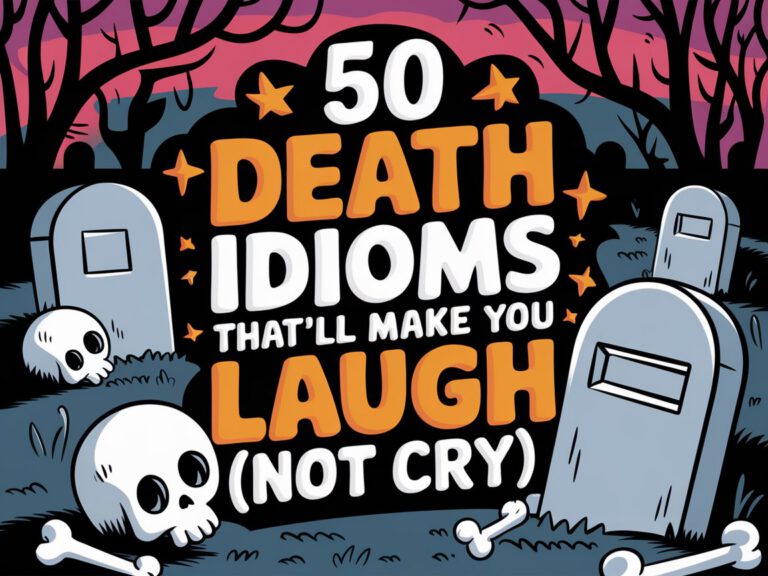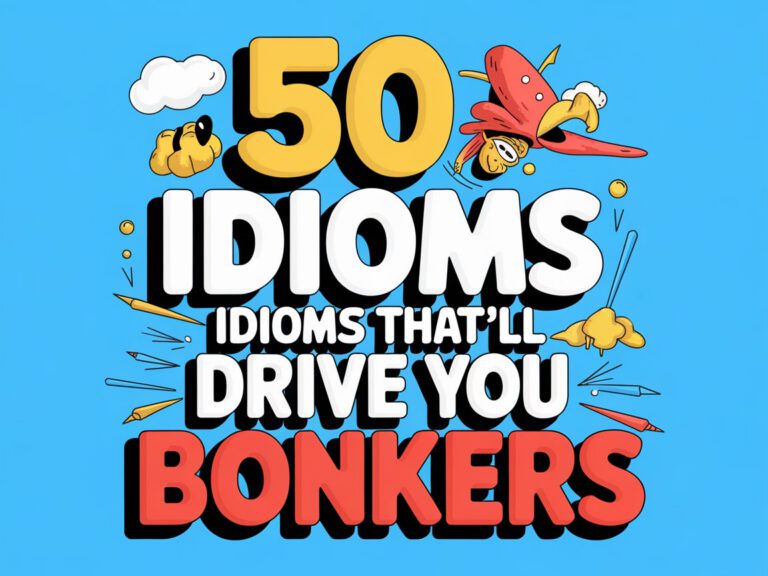50 Terrifying Idioms for Scared That’ll Give You Chills

Fear is one of our most primal emotions, and the English language has developed countless colorful ways to express it. Whether you’re absolutely terrified or just slightly nervous, these idioms for scared will help you articulate those spine-tingling moments with vivid precision.
The Psychology Behind Fear Language
According to Oxford University Press research, “words for abstract concepts at one time designated concrete things or actions.” Fear-related idioms often stem from physical reactions our ancestors experienced when facing danger.
The evolution of fear language follows fascinating patterns across cultures:
| Physical Reaction | Idiom Category | Examples | Cultural Origin |
|---|---|---|---|
| Heart palpitations | Cardiac metaphors | “Heart in throat” | Universal |
| Trembling | Movement idioms | “Shake like a leaf” | Germanic roots |
| Pallor | Color imagery | “White as a ghost” | Medieval European |
| Paralysis | Immobility phrases | “Frozen with fear” | Ancient Greek |
| Flight response | Escape idioms | “Run for the hills” | Military origins |
50 Spine-Chilling Idioms for Scared
Heart-Stopping Horror
1. Jump out of one’s skin When something startles you so badly that you feel like you’re literally jumping out of your body. This vivid expression perfectly captures that moment of extreme surprise.
“The fireworks made me jump out of my skin!”
2. Heart in one’s throat That choking sensation when fear makes your heart beat so hard it feels like it’s moved to your throat. It’s a universal experience that translates across cultures.
“Watching the tightrope walker had my heart in my throat.”
3. Make your blood run cold This chilling idiom describes fear so intense it feels like your blood has turned to ice. Medieval literature frequently used this expression to describe supernatural terror.
“The ghost story made my blood run cold.”
4. Heart skip a beat When sudden fear or surprise causes your heart to miss its regular rhythm. It’s often used for both positive and negative surprises.
“My heart skipped a beat when I heard the crash.”
5. Break out in a cold sweat Fear triggering the body’s stress response, causing perspiration despite feeling cold. This physiological reaction is so common it became an idiom centuries ago.
“Public speaking makes me break out in a cold sweat.”
Trembling Terror
6. Shake like a leaf Perhaps the most visual fear idiom, comparing human trembling to leaves shaking in the wind. This metaphor appears in literature dating back to the 1500s.
“The child shook like a leaf during the thunderstorm.”
7. Quaking in one’s boots Trembling so violently from fear that even your footwear seems to shake. This expression originated in the 1800s and adds a humorous touch to genuine terror.
“The thought of the job interview had him quaking in his boots.”
8. Tremble with fear A straightforward description of the physical manifestation of fear. Sometimes the simplest expressions are the most powerful.
“The rabbit trembled with fear as the hawk circled overhead.”
Pro-Tip: Use these trembling idioms when describing situations where fear has obvious physical effects. They’re particularly effective in storytelling and personal narratives.
Ghostly Pallor
9. White as a ghost When fear drains all color from someone’s face, they become as pale as a supernatural apparition. This idiom combines the visual impact of pallor with spooky imagery.
“She turned white as a ghost when she saw the spider.”
10. Pale as a sheet Similar to “white as a ghost,” but using household imagery. The comparison to bed linens makes this expression more relatable and less supernatural.
“After the roller coaster, he was pale as a sheet.”
11. Ashen-faced Describing the gray pallor that accompanies shock or fear. “Ashen” refers to the color of ash, creating a vivid image of lifeless complexion.
“The news left her ashen-faced and speechless.”
Frozen Fear
12. Scared stiff Fear so intense it causes physical paralysis. This idiom suggests being so frightened that you become rigid and unable to move.
“The horror movie left me scared stiff.”
13. Freeze with fear When terror causes complete immobilization. This expression captures the “freeze” response from the classic fight-flight-freeze reaction.
“I froze with fear when I saw the bear.”
14. Petrified Literally meaning “turned to stone,” this idiom suggests fear so overwhelming it transforms you into an immovable object.
“She was petrified when she realized she was lost.”
15. Paralyzed with fear Medical imagery describing the complete loss of motor function due to terror. It emphasizes the severity of the fear response.
“The accident left him paralyzed with fear of driving.”
Nervous Breakdown
16. Bundle of nerves Someone who’s extremely anxious or jittery. This idiom suggests that the person is made entirely of exposed, sensitive nerves.
“Before the presentation, she was a bundle of nerves.”
17. Have butterflies in one’s stomach The fluttering sensation in your stomach when you’re nervous. This gentle idiom softens the intensity of fear while remaining relatable.
“I always have butterflies in my stomach before flying.”
18. Get the jitters Nervous energy that manifests as fidgeting or shaking. “Jitters” suggests small, rapid movements caused by anxiety.
“Coffee gives me the jitters, especially before important meetings.”
19. On pins and needles Extreme nervousness or anticipation. The imagery of sitting on sharp objects perfectly captures the discomfort of anxiety.
“I was on pins and needles waiting for the test results.”
Hair-Raising Horror
20. Hair standing on end When fear causes your hair to literally stand up due to goosebumps. This idiom describes the physical reaction to extreme fright.
“The ghost story made my hair stand on end.”
21. Hair-raising An adjective describing something so frightening it makes your hair stand up. It’s commonly used to describe thrilling or scary experiences.
“The roller coaster was absolutely hair-raising.”
22. Make your hair curl Similar to hair-raising, but suggesting the fear is so intense it changes your hair’s structure. It’s often used humorously.
“That horror movie was scary enough to make your hair curl.”
Spooky Sensations
23. Get the heebie-jeebies A feeling of unease or mild fear. This playful expression was coined by American cartoonist W.B. Beck in 1923 and has remained popular ever since.
“That old house gives me the heebie-jeebies.”
24. Send shivers down one’s spine A chilling sensation that travels down your back when you’re scared. This idiom captures the physical pathway of fear through the body.
“The ghost story sent shivers down my spine.”
25. Give someone the creeps Causing an uncomfortable feeling of fear or disgust. “Creeps” suggests something crawling on your skin, creating visceral discomfort.
“That abandoned building gives me the creeps.”
26. Goosebumps The raised bumps on your skin when you’re cold or frightened. While technically not an idiom, it’s commonly used to describe fear reactions.
“The movie was so scary it gave me goosebumps.”
Extreme Terror
27. Scared out of one’s wits Fear so intense it seems to drive away all rational thought. This idiom suggests terror has overwhelmed your mental faculties.
“The sudden explosion scared me out of my wits.”
28. Frightened to death Hyperbolic expression suggesting fear so extreme it could be fatal. It’s commonly used for dramatic effect rather than literal meaning.
“I was frightened to death when I heard the noise.”
29. Scared witless Similar to “scared out of one’s wits,” suggesting fear has removed all intelligence or awareness. It emphasizes the overwhelming nature of terror.
“The horror movie left her scared witless.”
30. Scare the living daylights out of someone To frighten someone severely. “Living daylights” refers to consciousness or awareness, suggesting fear so intense it threatens your very being.
“The prank scared the living daylights out of me.”
Cowardly Behavior
31. Chicken out To withdraw from something due to fear. This idiom uses the chicken’s reputation for cowardice to describe backing down from challenges.
“He chickened out of the bungee jump at the last minute.”
32. Yellow-bellied Describing someone as cowardly. Yellow has long been associated with cowardice, though the exact origin remains unclear.
“Don’t be yellow-bellied – just ask her out!”
33. Scaredy-cat A playful term for someone who’s easily frightened. It combines “scared” with “cat,” perhaps referring to cats’ skittish nature.
“Stop being such a scaredy-cat – it’s just a movie!”
34. Lily-livered Describing extreme cowardice. The liver was once thought to be the seat of courage, and a white (lily) liver suggested a lack of brave blood.
“The lily-livered soldier refused to fight.”
Flight Response
35. Run for the hills To flee quickly from danger. This idiom suggests seeking the safety of high ground when threatened.
“When the wasps appeared, everyone ran for the hills.”
36. Take to one’s heels To run away quickly. “Heels” refers to the back of the foot, emphasizing the act of running.
“The thief took to his heels when he saw the police.”
37. High-tail it out of there To leave quickly due to fear or danger. “High-tail” compares human flight to animals raising their tails while running.
“We high-tailed it out of there when we heard the sirens.”
Anticipatory Fear
38. Have cold feet To become nervous about a planned action and consider backing out. This idiom originated in the 1800s and remains popular today.
“She had cold feet about the wedding and called it off.”
39. On tenterhooks In a state of anxious suspense. Tenterhooks were hooks used to stretch cloth, creating an image of uncomfortable tension.
“I was on tenterhooks waiting for the exam results.”
40. Bated breath Anxious anticipation. “Bated” means restrained or held back, describing the shallow breathing that accompanies anxiety.
“We waited with bated breath for the announcement.”
Startled Reactions
41. Jump out of your skin To be extremely startled. This expression emphasizes the violent nature of surprise reactions.
“The car backfiring made me jump out of my skin.”
42. Nearly jump out of one’s skin A milder version of the above, suggesting almost but not quite reaching maximum startlement.
“The doorbell nearly made me jump out of my skin.”
43. Bolt upright To suddenly sit or stand up straight due to surprise or fear. The word “bolt” suggests rapid, mechanical movement.
“The nightmare made him bolt upright in bed.”
Overwhelming Anxiety
44. At your wit’s end Completely overwhelmed by worry or fear. This idiom suggests you’ve exhausted all your mental resources for dealing with the situation.
“I’m at my wit’s end trying to figure out what’s wrong.”
45. Beside oneself with worry So anxious that you’re not thinking clearly. This expression suggests being outside your normal mental state.
“She was beside herself with worry when her child didn’t come home.”
46. Climbing the walls Extremely agitated or anxious. The imagery suggests being so restless you’d climb walls to escape your situation.
“The noise from upstairs has me climbing the walls.”
Unique Fear Expressions
47. Afraid of one’s own shadow Extremely timid or easily frightened. This idiom suggests being so nervous that even harmless things cause fear.
“After the accident, she was afraid of her own shadow.”
48. Whistle in the dark To maintain courage in a frightening situation through false bravado. This expression references the common practice of whistling to feel less afraid.
“His jokes were just whistling in the dark – he was terrified.”
49. Like a deer in headlights Frozen with fear or surprise, unable to react. This modern idiom references the way deer freeze when caught in car headlights.
“When the teacher called on him, he looked like a deer in headlights.”
50. Scared spitless Extremely frightened. This colorful expression suggests fear so intense it affects basic bodily functions.
“The roller coaster left me scared spitless.”
Pro-Tip: When using these idioms, consider your audience and context. Some expressions like “heebie-jeebies” are playful, while others like “scared spitless” are more intense and might not be appropriate for all situations.
Cultural Origins and Evolution
Many English fear idioms have fascinating historical roots. The word “panic” derives from the Greek god Pan, whose sudden appearances would “strike terror in the hearts of those who heard them.” Medieval European culture contributed expressions like “white as a ghost,” reflecting the period’s preoccupation with supernatural fears.
Germanic languages provided many of our trembling-related idioms. The Old English word “fær” originally meant “sudden calamity or danger,” evolving into our modern “fear.” This etymological journey shows how our ancestors’ concrete experiences with danger shaped abstract emotional language.
Pro-Tip: Understanding the historical context of these idioms can help you use them more effectively and appreciate their cultural significance.
Modern Usage and Context
Today’s fear idioms serve multiple purposes beyond simply describing terror. They can:
- Add humor to scary situations (“scaredy-cat”)
- Emphasize intensity (“scared out of my wits”)
- Create vivid imagery (“hair standing on end”)
- Show empathy (“I know that feeling”)
- Soften harsh emotions (“butterflies in stomach”)
Social media has given new life to many traditional fear idioms, with expressions like “give me the heebie-jeebies” finding fresh audiences online. The visual nature of these idioms makes them perfect for memes and viral content.
Tips for Using Fear Idioms Effectively
Match the intensity to the situation. Don’t use “frightened to death” for minor nervousness – save it for truly terrifying experiences.
Consider your audience. Some idioms are more formal (“bated breath”) while others are casual (“chickened out”).
Use them sparingly. Too many idioms in one conversation can sound forced or clichéd.
Practice pronunciation. Some idioms have tricky sounds – “heebie-jeebies” requires careful articulation.
Pro-Tip: When learning these idioms, try to associate each one with a specific memory or experience. This personal connection will help you remember and use them naturally.
The Psychology of Fear Language
Research shows that using vivid fear idioms can actually help process and reduce anxiety. By giving concrete, often humorous names to our fears, we gain a measure of control over them. Saying “I have butterflies in my stomach” is less overwhelming than simply stating “I’m terrified.”
This linguistic phenomenon, called “affect labeling,” demonstrates why fear idioms have remained popular across cultures and centuries. They serve as emotional release valves, allowing us to express intense feelings in socially acceptable ways.
Regional Variations
While many fear idioms are universal, some have regional preferences:
- British English favors “get the wind up” (become frightened)
- American English prefers “get the jitters” (become nervous)
- Australian English uses “scare the bejesus out of” (frighten severely)
These variations reflect cultural differences in how fear is expressed and perceived across English-speaking nations.
Teaching Fear Idioms
For language learners, fear idioms present unique challenges because they often don’t translate literally. The key is understanding the underlying emotion and physical reaction being described. Visual aids, personal stories, and dramatic demonstrations can help make these expressions memorable and meaningful.
Pro-Tip: When teaching or learning these idioms, act them out! Physical movement helps embed the expressions in memory and makes them more natural to use.
The Future of Fear Language
As our world changes, so does our language of fear. New idioms emerge from contemporary experiences – “going viral” now describes the spread of frightening information, while “ghosting” describes the fear of sudden abandonment in relationships.
Digital communication has also influenced how we express fear. Emoticons and emojis now accompany traditional idioms, adding visual elements that reinforce the expressions’ meanings.
Frequently Asked Questions
Which fear idiom is most commonly used in English? “Scared to death” and “jump out of one’s skin” are among the most frequently used fear idioms in modern English. They’re versatile expressions that work in both casual and formal contexts.
Are fear idioms the same in all English-speaking countries? While many fear idioms are universal, there are regional variations. British English, American English, and Australian English each have some unique expressions alongside shared ones.
How old are most fear idioms? Many fear idioms date back centuries. “Heart in one’s throat” appeared in literature as early as the 1500s, while “heebie-jeebies” was coined in 1923. The age varies significantly among different expressions.
Can I use multiple fear idioms in one sentence? It’s generally better to use one strong idiom rather than combining multiple ones. Too many idioms in one sentence can sound unnatural or confusing to listeners.
Do fear idioms work in formal writing? Some fear idioms are appropriate for formal contexts (“bated breath,” “on tenterhooks”), while others are strictly casual (“scared spitless,” “chickened out”). Consider your audience and purpose when choosing.
Conclusion
Fear idioms represent one of English’s most colorful and expressive linguistic categories. From the gentle “butterflies in stomach” to the intense “scared out of my wits,” these expressions capture the full spectrum of human fear responses. They connect us to our ancestors’ experiences while providing modern speakers with vivid, memorable ways to communicate complex emotions.
What makes these idioms particularly powerful is their ability to transform abstract emotional states into concrete, often humorous images. When we say someone is “shaking like a leaf,” we create a visual metaphor that instantly communicates both the intensity and the physical nature of their fear.
As language continues to evolve, new fear idioms will undoubtedly emerge while others fade from use. However, the fundamental human need to express and share our fears ensures that this rich category of expressions will remain vital and relevant for generations to come.
The next time you feel that familiar chill of fear, remember that you’re not alone – humans have been creating colorful ways to describe these feelings for centuries. Whether you’re “quaking in your boots” or just have “butterflies in your stomach,” you’re participating in a linguistic tradition that spans cultures and centuries.
Helpful Resources
- https://blog.oup.com/2018/06/etymology-emotional-few-remarks-fear/
- https://www.learn-english-today.com/idioms/idiom-categories/anxiety-fear/anxiety-fear1.html
- https://idiominsider.com/idioms-for-scared/
- https://dictionary.cambridge.org/us/topics/fear-and-danger/afraid/
- https://langeek.co/en/vocab/subcategory/1782/word-list






